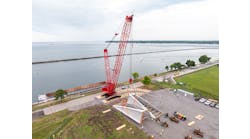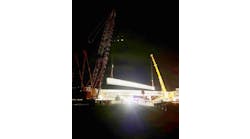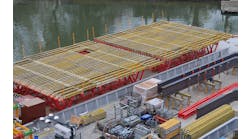By: Peter C. Taylor, Ph.D., P.E., and Shrinivas B. Bhide, Ph.D., P.E., S.E Contributing Authors
The Federal Highway Administration (FHWA) encourages the use of high-performance concrete to improve the long-term performance of the nation’s infrastructure at lower life-cycle costs. For its purposes, the FHWA uses 11 performance criteria to define high-performance concrete (HPC), and it designates three levels of performance for each criterion, with Grade 3 being the most stringent. For FHWA projects, the specifier is expected to select the criteria necessary for a given element, then select an appropriate performance grade. It is not necessary or desirable to specify the same performance grade for all characteristics.
To make it easier for specifiers to use HPC for bridges, the Portland Cement Association has worked with CTLGroup to develop a Guide Specification for High Performance Concrete for Bridge Elements. This document provides mandatory language that the specifier can cut and paste into project specs, as well as guidance on what characteristics should be specified in a given case and what criterion is needed to ensure satisfactory performance. It includes commentary that tells how to obtain the desired performance for each characteristic. In cases where two performance criteria are in conflict, the commentary advises the user how to balance conflicting requirements.
The specifier can change criteria as needed for a particular job, but the project specifications should address the particular performance required and not use compressive strength as a surrogate. Where multiple performance criteria are included in the Guide Specification, the commentary provides recommendations on how to select the right one.
The final review of the Guide Specification is currently in progress, and the document will be published sometime in 2004.
The Guide Specification is set up in two parts. The first part is a model specification, in mandatory language that sets out requirements for each of the parameters that may be considered important for the structure in question. The specifier can then cut and paste the needed clauses into the specification. Where numerical limits are required in the specification, they are left blank so that the specifier can choose values appropriate for the project.
Part 2, the associated commentary, is laid out using the same numbering system and provides guidance for the specifier in selecting which clauses are relevant to a particular project and what limits should be selected under which circumstances. The limits generally are based on the three classes FHWA uses in its definitions of HPC. The commentary also provides guidance on when a requirement should be omitted.
Use as needed
Specifiers are often tempted to select the highest grade for every parameter with the aim of achieving the best possible product. The commentary points out that this practice is undesirable and, in some cases, requirements may be mutually incompatible. For instance, low permeability is normally achieved by using high cement contents and low water-to-cement ratios. This in turn will increase the heat of hydration and the risk of thermally related cracking. Similarly, requiring high resistance to freezing and thawing in a structure built in a temperate environment will add unnecessary cost to the structure.
This approach can be extended to the individual elements within a single structure. A bridge deck in a northern location will require freeze-thaw resistance and low chloride penetration. The beams supporting that deck, however, are unlikely to be exposed to road salts, and compressive strength and creep may be the only parameters that need to be addressed. Likewise, the supporting columns are likely to be massive and will require attention to the heat of hydration and crack prevention.
Specifiers should set out only those parameters that are necessary, using appropriate limits for the elements being specified. The commentary provides a wealth of information on helping them do just that, including references to many existing specifications and standard methods and to the relevant literature.
The Guide Specification covers the following parameters:
Materials and concrete performance
- Abrasion resistance: for bridge decks;
- Chloride ion penetration: for bridge decks and other elements subject to deicing salts and for all bridge elements exposed to seawater;
- Compressive strength: for stripping times of forms and for all other structural requirements;
- Creep and modulus of elasticity: for structural elements;
- Freeze-thaw durability: for concrete exposed to freezing and thawing in saturated or near-saturated conditions;
- Scaling resistance: for concrete surfaces exposed to deicing salts, i.e., bridge decks;
- Shrinkage: for restrained elements; however, there is little correlation between the standard shrinkage test and structural performance;
- Sulfate resistance: for foundations and substructures in areas where sulfates are present in the soil or groundwater;
- Consistency: the specifier can elect not to specify a consistency but rather allow the contractor to elect a value while imposing a limit on variability; and
- Alkali-silica reactivity: for areas where aggregates are potentially reactive.
Submission
- Concrete mixture design;
- Production facility certification;
- Materials sample retention for subsequent evaluation should incompatibilities or other problems occur;
- Temperature control plan for massive structures where relevant;
- Crack control plan for elements where the risk of cracking is unacceptably high; and
- Curing plan for all concrete.
Quality Management
- Quality control: contractor’s responsibility;
- Quality assurance: owner/specifier’s responsibility; and
- Quality audits: owner/specifier’s responsibility.
Production
- Equipment quality;
- Mixing procedures and timing;
- Temperature limits;
- Trial batches to minimize risk of the unexpected occurring in the field;
- Site addition of water or chemicals;
- Tickets and records; and
- Measurement methods and tolerances.
Practice makes clear
Following is an example that shows how the concrete for a particular bridge element might be specified. Note that the laboratory curing methods used to develop the concrete mix proportions should simulate the anticipated field curing conditions. In addition, the aggregates used must be tested for their potential alkali reactivity. If the same aggregates are to be used throughout the structure, the required testing need be done only once for each aggregate.
Bridge deck
A bridge deck exposed to deicing salts needs to resist chloride ion penetration in order to delay the onset of chloride-induced corrosion for as long as possible. Both freeze-thaw durability and scaling resistance also are necessary. Depending on structural requirements, the deck may need to have some minimum strength at the age when the bridge is opened to traffic. A strength or modulus that is too high, however, may increase the tendency of the deck to crack, which will be detrimental to its durability, particularly in an environment conducive to corrosion. In such a case, the specifier might elect to include only the minimum strength requirement. The specification would then be as follows.
Chloride ion penetration: The concrete shall have a charge passed in six hours of 1500 coulombs or less when tested according to AASHTO T 277 at age 56 days. The specimens shall be moist-cured to age seven days, after which they shall be stored at 70-75°F and 50 ±5% RH until the time of test.
Compressive strength: The concrete shall have a compressive strength of at least 4,000 psi when tested according to AASHTO T 22 at age 28 days. The specimens shall be moist-cured to age seven days, after which they shall be stored at 70-75°F and 50 ±5% RH until the time of test. Either 4-by-8- or 6-by-12-in. cylinders may be used.
Freeze-thaw durability: The concrete shall have a durability factor of 90% or greater when tested according to AASHTO T 161, Procedure A. Scaling resistance: The concrete shall have a visual rating of 1 or less when tested in accordance with ASTM C 672, except that the concrete shall be moist-cured to an age of 28 days, after which it shall be stored in air for 14 days at 70-75°F and 50 ±5% RH, before being exposed to deicing chemicals. Note that ASTM C 672 normally uses a solution of 4 g anhydrous CaCl2 per 100 mL solution as the deicing medium, but allows the use of other deicing chemicals. If the owner routinely uses a different deicing chemical, the specification should require that deicing chemical to be used in the test.
As can be seen from the above example, the Guide Specification for High Performance Concrete for Bridge Elements will facilitate the design of concrete bridges by helping specifiers first to determine the appropriate performance criteria for each structural element, then to write clear specifications that will ensure the criteria are met.
About The Author: Taylor is senior engineer and manager of materials consulting for CTLGroup, Skokie, Ill. Bhide is bridge program manager for the Portland Cement Association, Skokie, Ill.


